Netflix is fundamentally transforming its gaming strategy by abandoning AAA game ambitions and focusing on casual, party-style games designed for family and group play via TV and smartphone. This shift was marked by the official launch of Netflix Game Night, a collection of accessible party games where users can connect their smartphones as controllers and play together in the living room.

- “Casual Party Games: Netflix’s New Weapon in the Time Share Wars”
- “Goodbye AAA, Hello Living Room — Connecting Friends and Families Through Game Night”
- “Winning Engagement: From Streaming Originals to Interactive Play”
After four years in the gaming business—including studio closures and reorientation—Netflix now prioritizes mass-appeal, low-barrier party games over solo mobile or competitive AAA titles. Key releases include licensed games (LEGO Party, Pictionary: Game Night, Tetris Time Warp), exclusive tie-ins (Dead Man’s Party: A Knives Out Game), premium remasters (Red Dead Redemption), and a live gameshow called Best Guess Live (where US subscribers can win real prizes).
The true competitor: Not legacy game studios, but YouTube . Nielsen data shows YouTube’s US video watch time is over 50% greater than Netflix’s. Increasing user “reengagement” is core—by encouraging users to play casual games, then transition seamlessly to content streaming, Netflix hopes to boost overall engagement time.
Casual games are now a strategic tool—not the end goal. The ultimate aim is to raise engagement across the whole platform, drive cross-promotion between IPs, and experiment with content-game integration.
Market landscape: Netflix vs Amazon GameNight
According to the October 2025 TV party games provider scorecard, Netflix and Amazon: GameNight stand out as dominant forces in the “low cost, low difficulty” category with the largest market reach (see attached chart). These offerings are optimized for family and group play, featuring the biggest bubbles in distribution—ideal for accessible party gaming experiences.
Strategic Implications
- Netflix uses games as a means to win attention and boost time share—not to compete as a primary gaming company.
- “Time share” has become the key metric for streaming platforms as Hollywood rivals struggle to erode Netflix’s dominance.
- The Korean market, with its blend of global content and gaming leadership, is well-positioned to leverage similar content-game-commerce ecosystem strategies.
Netflix’s “Game Night” launch and strategic pivot reflect an industry-wide evolution from big-budget gaming to accessible family entertainment—with a clear eye on engagement metrics and competition with YouTube . This model speaks directly to content creators and service providers globally seeking to build extended, cross-genre entertainment ecosystems.
| Brand / Series | Cost to Consumer | Difficulty of Play | Distribution Strength (Bubble Size) | Main Feature / Highlight |
|---|---|---|---|---|
| Amazon: GameNight | Low | Low | Largest (most prominent) | Biggest global reach, top accessibility, family/friends focus |
| Netflix: Party Games | Low | Low | Large | Integrated with video streaming, smartphone-TV sync, party/family friendly |
| Jackbox Games: Party Packs | Low | Low | Large | Leading online multiplayer party game |
| Epic Games: Fall Guys | Low | High | Large | Competitive, challenging party gameplay |
| Ubisoft: TV game show | Low | Low | Medium | Official TV show-based interactive party games |
| Ubisoft: Just Dance | High | High | Large | Music/dance franchise, strong brand recognition |
| Team17: Overcooked | High | High | Medium | Cooperative, skill-heavy party game |
| Nex: First-party titles | High | Low | Small | Developer-led, casual/puzzle focused |
| Nintendo: Party/Sports | High | Low | Large | Classic party/sports games for wide audiences |
넷플릭스 vs 아마존: TV 파티 게임 ‘전쟁’이 엔터테인먼트 미래를 흔든다
글로벌 미디어 산업에서 넷플릭스와 아마존이 또 한 번 판을 흔든다. 2025년, 이 두 공룡은 TV를 기반으로 한 파티 게임 시장 공략에 본격적으로 나서면서, 영상 시청의 '수동적 소비'를 '능동적 참여'로 바꾸는 대전환을 꾀하고 있다. 이는 넷플릭스가 자신의 게임 전략을 AAA에서 캐주얼 게임으로 전환한 것과 일맥상통한다.
글로벌 게임 시장은 콘솔(Console) 등을 보유하면서 게임에 보다 몰입하는 ‘게이머’가 많지만 아직 상당수는 ‘시간을 때우는 용도’로 게임을 즐기는 캐주얼한 유저의 폭도 넓다.
옴디아(Omdia)는 최근 북미와 유럽, 한국을 포함한 주요 시장에서 콘솔을 소유하지 않은 게임 유저가 25~40%에 달한다는 조사 보고서(Netflix vs. Amazon: a new battle for TV gaming)를 내놓기도 했다.

출처 옴디아
한 때 게임 시장까지 뛰어든 것처럼 보였던 넷플릭스와 아마존은 결국 ‘게임’을 자신들의 주된 경쟁력을 높이는 수단으로 활용하기 시작했다.

넷플릭스와 아마존 모두 별도 하드웨어 없이, 스마트폰만 손에 쥐고 TV 앞에서 가족·친구가 파티 게임을 즉시 즐길 수 있도록 서비스를 내놓았다.
TV 파티 게임 시장(2025년 10월 기준) 요약
즉, ‘게임’을 즐기다가 자연스럽게 넷플릭스와 아마존에서 콘텐츠를 보거나 쇼핑을 즐기는 ‘경험(experience)’으로 전환을 유도한다는 이야기다. 게이머를 시청자(Audience)로 전환시키는 것이 아닌 시청자에게 또 다른 경험을 제공해 ‘재몰입도’를 높이는 전략이다.
한 해 중 엔터테인먼트 콘텐츠(게임, 스포츠, 드라마, 영화) 이용률이 가장 높은 연말연시(추수감사절~크리스마스)가 곧 이 전략의 성패를 가르는 실험 무대가 된다. 기존 파티 게임 강자인 닌텐도, 잭박스 등과 경쟁하며, 내부적으로는 기존 TV/영상 소비와의 시간 경쟁도 치열해질 전망이다.






![[모집]1월 9일~14일 글로벌 AI 스템 캠프(자료집)](https://cdn.media.bluedot.so/bluedot.kentertechhub/2025/11/3kf0x5_202511031830.png)
![[MIPCOM2025]글로벌 엔터테인먼트 트렌드](https://cdn.media.bluedot.so/bluedot.kentertechhub/2025/10/duxlsp_202510170000.png)
![[보고서]생성AI와 애니메이션](https://cdn.media.bluedot.so/bluedot.kentertechhub/2025/09/c49fxu_202509271057.png)


![[보도자료]Kocowa, 유럽 진출 1년 성과](https://cdn.media.bluedot.so/bluedot.kentertechhub/2025/07/d4i5qa_202507142153.png)



